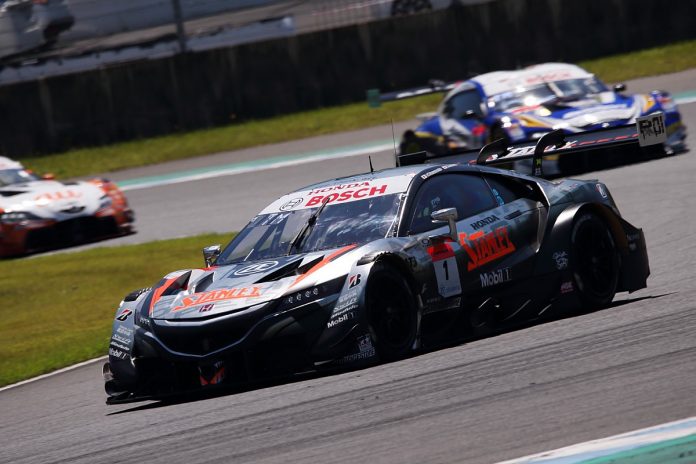Sunday’s Motegi race didn’t mark the Honda NSX-GT’s first win of the year, but it was arguably the first time the Sakura-based brand beat Toyota fairly and squarely in 2021.
After Bertrand Baguette and Koudai Tsukakoshi’s Full Course Yellow-assisted victory at the Fuji 500km in May for Real Racing, Honda’s Head of GT500 Auto Development Tomohiro Onishi expressed his concern that the GR Supras had come so close to victory despite the ballast of success.
Also read:
Because of this, a slightly more emphatic performance by Team Kunimitsu duo Naoki Yamamoto and Tadasuke Makino, who turned pole into victory at Motegi, was such a relief for Honda.
“In Okayama we had to go to a ‘Supra Festival’ so we thought we had to do something to compete against the Supra,” said Onishi.
“It would have been a shame if we had to suffer another ‘Supra Festival’ in Motegi, where we did well last year [winning both races]so that we could motivate ourselves again. We made some detail changes that we probably wouldn’t have made in a normal situation.
“It was a local race for us [HRD], for Yamamoto and for Auto Technic Japan, the maintenance shop for the # 1 car, so we were determined to win. It was a relief that we could win. “
While Yamamoto and Makino were the first GT500 polesitters to claim victory in 10 races, their way to the top step of the podium was anything but easy as they faced the # 19 Racing Project Bandoh GR Supra of Ritomo Miyata and Yuji. Kunimoto had to compete.
With the Yokohama tires on the Bandoh machine, which worked well in the scorching heat of 34 degrees Celsius, Kunimoto was able to overtake Makino at the front in the seventh of 63 laps.
The Kunimitsu car came to Motegi with relatively little success ballast, 22kg, but Honda Team ARTA, which uses Bridgestone, didn’t even make it out of the first quarter, despite only carrying 14kg extra.
On a day when the extreme heat made overtaking difficult and none of the four tire manufacturers suffered from extreme wear and tear, qualifying was even more important than usual. If the Kunimitsu car had qualified in a similar position to ARTA, it would be an easy win for Been Toyota.
“In the race the pace of the # 19 car was very good and to be honest I thought it would be very difficult to keep the top position,” said Honda project manager Masahiro Saiki. “But Makino could keep up [with Kunimoto after being passed for the lead], and in the end Yamamoto was able to defend it.
“The tires were key, but with Bridgestone, Yokohama, Dunlop and Michelin all running at a similar pace, I believe the win was thanks to the two drivers in the # 1 car who took pole in qualifying.”

At the penultimate race at Motegi last year, Honda’s fuel efficiency advantage, allowing earlier pit stops, was key to the NSX-GT’s dominance, and the fuel economy of the front-engined car was seen again on Sunday.
ARTA pitted the first GT500 on lap 23 of 63, followed by the Kunimitsu Honda on lap 24. In contrast, the first Toyota only pitted on lap 26, while the Bandoh GR Supra left its stop on lap 28.
While it was the time on the pit lane itself that proved most crucial in the leadership battle, with a difference of about 5.7 seconds between the respective laps of the # 1 and # 19, Yamamoto was also able to get 1.2 seconds out of Kunimoto’s Toyota Equipped with fresh Bridgestone tires on lap 27.
But it was the ARTA pairs Tomoki Nojiri and Nirei Fukuzumi who showed the power of the undercut best when they rose from ninth place – Fukuzumi spent his entire stint behind the # 38 Cerumo GR Supra – except for fifth place thanks to the clear Air after their early start stop.
“This is a track where you will run out of fuel by pitting a third of the way back, but when I watched the race I felt like Honda has a bigger window when it comes to fuel efficiency,” said Saiki. “We wanted to enable the teams to pit at a minimum distance and run in clear air.
“Honda has an advantage in this area and on a circuit like Motegi where fuel consumption is very high it can be an advantage.”

Next month, SUPER GT will travel to Suzuka following the postponement of the official third round of the season – originally planned for the end of May – where similarly high temperatures are expected.
While ARTA is expected to claim Honda’s honor at the top of the field with the lightest handicap of the three Bridgestone-tipped NSX GTs, Saiki hopes the track will give an opportunity to Dunlop-equipped Mugen and Nakajima Racing alike to shine.
“This time we also confirmed that Dunlop’s race pace hasn’t dropped as much compared to last year and I think that will be the case at Suzuka next month too, so we’re looking forward to this race too,” said Saiki.
“Yokohama is more consistent than last year even in the summer heat, so I think the next races will continue to be tightly contested. In these races, our lighter cars in particular will have to score points, including # 8.” [ARTA], so I hope you try very hard. “
Onishi, meanwhile, is hungry for a first GT500 victory for an NSX at Suzuka since 2018, after Nissan swept the board in two races of Honda’s own Japanese Formula 1 Grand Prix last year.
“I think we are now able to take advantage of the NSX’s strengths no matter which route we go,” he said. “Last year at Suzuka we were beaten by the GT-R, but because Suzuka is also a home track for Honda, we somehow want to win there too.”

